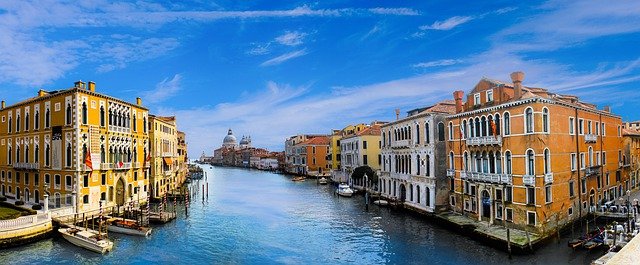By Tim Lambert
Early Venice
According to tradition, Venice was founded in 421 AD. At that time a Celtic people called the Veneti lived along the coast of what is now Northeast Italy. Since 49 BC they had been Roman citizens. However, in 453 Attila the Hun invaded Italy. In terror, some Veneti fled to islands in the lagoon and built a village there. They soon formed a loose federation. Then in 568 AD, a people called the Lombards invaded the mainland and many Veneti fled to the islands swelling the population.
At first, Venice was controlled by the Byzantine Empire (the Eastern half of the Roman Empire, which survived the fall of Rome). However, in 726 the Venetians partly gained their independence and elected Orso Ipato as doge (their word for Duke).
In 810 the Franks tried but failed to conquer the Venetians. Meanwhile, Venice flourished as a trading center and ships sailed to and from its ports. Its population grew steadily. In 828 the body of St Mark was smuggled from Egypt to Venice. St Mark then became the patron saint of the city.
In the Middle Ages Venice continued to flourish as a port and trading center. Meanwhile, in 1199 a fourth crusade was proposed. The Venetians agreed to build a fleet of ships to ferry the Crusaders. However, when the Crusader army assembled they were unable to pay for the ships. So the Venetians persuaded them to join an expedition to raid Constantinople. Venetians and Crusaders captured the city in 1204 and they looted it. Venice was also involved in other wars at that time. The Italian city of Genoa was a powerful rival to Venice and during the 13th and 14th centuries, the Genoese and Venetians fought 5 wars.
Furthermore, in 1348, the Black Death devastated the population of Venice. Therefore in 1403, Venice introduced quarantine. Ships arriving from infected areas had to stop at an island called Lazaretto and the passengers had to wait for 40 days before they were permitted to enter the city.
In the 15th century, Venice faced a new threat – the Turks. In 1453 they captured Constantinople and afterward, they advanced into Southeast Europe. In 1489 Venice came to rule Cyprus. However, in 1571 the Turks conquered the island.
Furthermore, in 1508 several European countries formed the League of Cambrai and went to war against Venice. However, after 8 years of war, the map was largely unchanged. More serious for Venice was the discovery of North and South America. The result was that trade shifted away from the Mediterranean. Furthermore, in 1630 Venice was struck by the plague again.
During the 17th century, Venice gradually lost power and influence. In the 18th century, Venice was politically unimportant although the arts such as opera flourished. Then in 1797, Napoleon dissolved the Republic of Venice. However, after his fall in 1815, Venice was handed to Austria.
Modern Venice
The railway reached Venice in 1846. However, Venice did not prosper under Austrian rule. In 1848 revolutions swept Europe and Venice rose in rebellion against the Austrians. For a short period, Daniele Manin became president of an independent Venice. However Austrian forces bombarded the city and Venice was forced to surrender in August 1849. Yet in 1866 the Austrians were defeated by the Prussians and Venice was allowed to join the new nation of Italy.
In the late 19th century Venice flourished as a port and a manufacturing center. Then in 1933, Mussolini built a road from the mainland to Venice. During the Second World War, Venice was undamaged by fighting but the Jewish population was deported.

In 1966 Venice suffered a severe flood but the city soon recovered. Today tourism is the mainstay of Venice. However, the population of Venice has fallen sharply since the mid-19th century. In 2024 the population of Venice was 257,000.
Last revised 2025